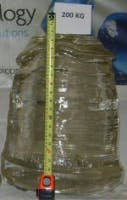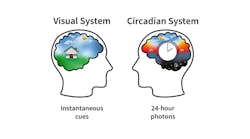In the future, the ability to grow very large sapphire crystals could enable Rubicon, based in Franklin Park, Illinois, to offer large-size optical windows and next-generation wafer products with dimensions over 12 inches. The company says its proprietary ES2 crystal growth technology and sapphire processing capabilities can continue to be scaled to produce even larger-size sapphire products in the future.
Currently in production, Rubicon grows bulk sapphire crystals up to 85kg in production volumes, and supplies large-diameter sapphire wafers up to 8 inch diameters and optical windows up to 10 inch dimensions. Many LED manufacturers use 2- and 3-inch diameter sapphire, a small number use 4-inch wafers and some have started to investigate 6-inch wafers.
“We have once again demonstrated our capabilities as a leader in sapphire growth technology for large-size sapphire by successfully growing this unprecedented sapphire crystal,” said Raja Parvez, CEO of Rubicon Technology. “This growth capability now opens the door for Rubicon to provide customers with even larger size, very high-quality, sapphire products.
Parvez added that the “super boule” growth process will soon be “operationalized” into production volumes that will enable new applications for sapphire windows and wafers.
Why larger diameter?
At a recent conference in Hong Kong, Parvez explained the rationale behind the LED industry’s move to larger diameter wafers. “The availability of cost effective large diameter sapphire wafers and also LED processing equipment capable of manufacturing large diameter wafers is enabling LED producers to improve their process yields and chip throughput which reduces their overall chip costs,” he said.
These factors also reduce the overall capital investment necessary to keep up with the rapidly growing LED market. As LEDs penetrate into new high volume applications, the combination of lower costs and improved performance is necessary for LEDs to fully replace traditional, less efficient lighting technologies.
“In a time when the industry is closely monitoring cost and performance, we believe that moving to larger diameter LED wafer production will significantly reduce the overall cost of LED chips and also enhance the performance of LED lamps,” added Parvez.
“We expect adoption of 4-inch wafers to continue to rapidly increase in 2009 and 2010. While Rubicon is currently already providing high-quality 6-inch wafers to our customers, we expect 6-inch wafers to move to volume production starting in 2010 with more widespread adoption in 2011.”
Parvez added that 8-inch and larger sapphire wafers are already available and will provide the roadmap for the future of LED production. “The availability of these larger diameter wafers combined with increased throughput and process yields and the economics of competitive pricing will help the LED market become more successful,” he concluded.






